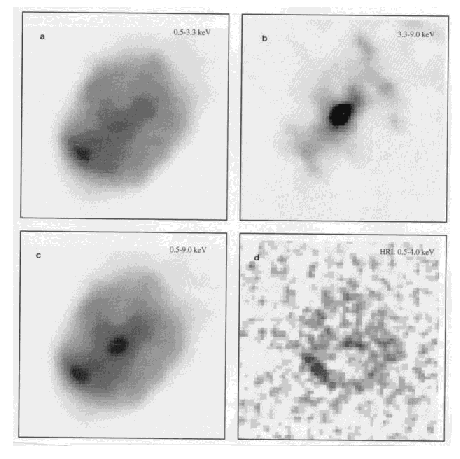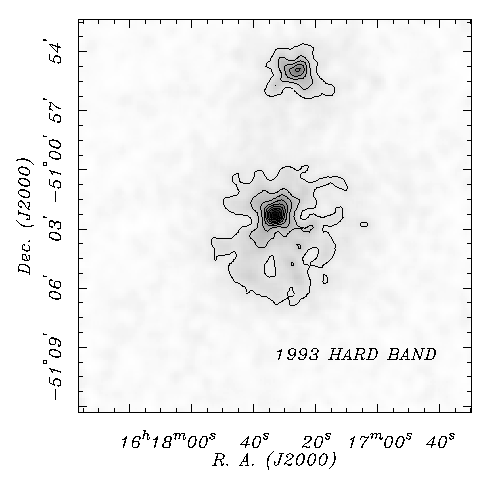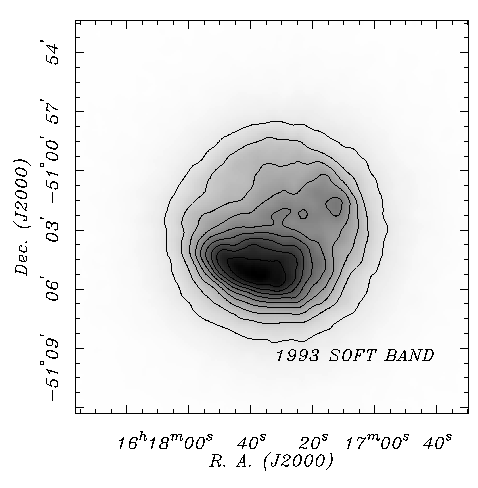Supernova Remnants
The unprecedented broad bandwidth and excellent spectral resolution of ASCA has had a major impact on all areas of research into the nature of supernova remnants (SNRs). Recent results from ASCA have increased the number of neutron star/SNR associations, debunking the decade-long mystery of the paucity of such associations. Additionally, ASCA has uncovered localized regions of non-thermal X-ray emission inside of SNRs which are not associated with the synchrotron nebulae but are produced by previously unrecognized mechanisms. ASCA maps of SNRs in prominent X-ray emission lines and selected continuum bands show variation in temperature, ionization, chemical composition, and, indeed, even the nature of the underlying emission mechanism. ASCA's increased sensitivity has allowed for a systematic study of the remnants in the LMC leading to the discovery of new ejecta-dominated remnants and an independent measurement of the gas-phase abundances of the LMC. Highly absorbed Galactic SNRs, which were weak and nondescript in previous soft X-ray observations, turn out to be remarkable objects with booming emission lines when observed using ASCA. These and other discoveries are leading to new insights into the nature of the ejecta of young remnants, the physics of supernova-induced shock waves, and the discovery and study of pulsar-powered synchrotron nebulae.The Connection between Neutron Stars and Supernova Remnants
Neutron Stars (NS) are thought to originate in SN explosions, however the relatively few known associations of NS with SNR had led some to doubt the underlying ideas of NS formation. ASCA has dramatically improved this situation by increasing the number of known associations. Among the current generation of X-ray instruments, only the ASCA instruments possess the capability to separate the soft, mostly thermal emission from the interstellar material swept up by the SN shock from the hard, non-thermal emission from the synchrotron nebula around a pulsar. If the compact object cannot be detected directly, ASCA allows us to infer its existence by detecting its interaction with the surrounding medium. Since this emission is not subject to the beaming effects of the pulsar emission, it is significantly more likely to be detected.Perhaps, the best example of the contribution of ASCA to this field is the case of the SNR G11.2-0.3. Vasisht et al. (Fig. 1;1996 ApJ 456, L59) used ASCA to detect a plerion in this remnant, which was only hinted at by previous X-ray observations, and Torii et al. (1997 ApJ 489, L145) detected a 65 ms pulsar with ASCA, which had not been detected in the radio. G11.2-0.3 was suggested to be the remnant of the historical SN of A.D. 386 (Clark & Stephenson 1977); the rapid pulsation and the temperature of the shock derived from the ASCA data are both consistent with a remnant age of ~1600 yr. This is only the second association of a pulsar with a historical supernova after the Crab and its pulsar.
The detection of a synchrotron nebula around an as yet undetected pulsar also lends support to the standard picture of NS birth and SNR evolution. Harrus et al. (1996 ApJ 464L, 161) detected the X-ray synchrotron nebula around the known radio pulsar PSR B1853+01 in the SNR W44. In contrast, Slane et al. (1997 ApJ, 485, 221) report the detection of a plerion in CTA-1 which was previously unknown in the radio. Harrus, Hughes, & Slane (1998 ApJ, 499, 273) report the detection of the synchrotron nebula in MSH11-62 which was known in the radio. Other remnants for which ASCA has detected a localized region of non-thermal emission are Kes 75 (Helfand 1994 New Horizons meeting), G292.0+1.8 (Torii et al. IAU proceedings), G327.1-1.1 (Sun et al. in preparation), and MSH15-56 (Plucinsky et al. 1998 Elba Proceedings). ASCA also detected the plerionic component in the SNR N157B in the LMC which prompted a followup observation by RXTE, which detected a 16 ms pulsar !

Figure 1. G11.2-0.3 in four energy bands in the adjacent panels. The upper left is the ASCA band from 0.5 to 3.3 keV, the upper right is the ASCA band from 3.3 to 9.0 keV, and the lower left is the ASCA band over the entire band from 0.5 to 9.0 keV. The lower right panel is the Einstein HRI. The ASCA data demonstrate clearly the existence of the X-ray plerion. The image is from Vasisht et al. 1996 (ApJ\ 456, L59).
Non-thermal Emission in SNRs
ASCA has detected localized regions of non-thermal X-ray emission which cannot be explained by synchrotron emission from a pulsar nebula. ASCA observations solved the long-standing mystery of the spectrum of SN1006 by localizing the non-thermal emission to the bright rims of the remnant (Koyama et al. 1995 Nature 378, 255), which has been interpreted as synchrotron emission from electrons with energies up to 100 TeV accelerated in the remnant blast wave (Reynolds 1996 ApJ 459, L13). ASCA discovered an extended region of hard X-ray emission in the SNR IC 443 (Keohane et al. 1997, ApJ 484, 350). It is coincident with a region of strong interaction between the remnant shock, and a dense molecular cloud. The authors speculate that the hard X-ray emission arises from TeV electrons whose population has been enhanced by virtue of shock-cloud collisions. If this is correct, then ASCA has unveiled a second means by which supernova remnants create high energy cosmic rays.Perhaps the most revolutionary observations will be those of the enigmatic remnant G347.5-0.5. This remnant was first detected as a bright source in the ROSAT all-sky survey and was resolved into a shell-type SNR. The bright NW shell was caught serendipitously in an ASCA galactic plane survey pointing and the spectrum was revealed to be non-thermal (Koyama et al. 1997 PASJ 49, L7). ASCA observations of the entire remnant show that the outer shell and the interior of the remnant also have a non-thermal spectrum (Slane et al. 1998 ApJ in preparation). There is no evidence of any thermal X-ray emission from any part of this remnant; this is a puzzling yet exciting result! The shell-type X-ray morphology, completely non-thermal spectrum, and relatively large size are difficult to explain by the mechanisms observed in other remnants; nevertheless, these data confirm the power of ASCA's imaging and spectral capabilities.
SNR Surveys
Two different types of surveys have been initiated in the last several years to utilize ASCA's unique capabilities to provide moderate-resolution spectra of heavily absorbed objects. First, a followup of ROSAT all-sky survey sources which are believed to be extended and which are coincident with known radio SNR has been started. Three of the first five targets have been detected in the X-rays with ASCA. G337.2-0.7 exhibited booming lines of Si, S, Ar and Ca with supersolar abundances indicating that it is possibly a young, ejecta-dominated remnant. G309.2-0.6 also has strong Si and S lines in addition to a strong Fe line. G7.7-3.7 has a thermal spectrum with nearly solar abundances. The second survey project is aimed at detecting small diameter radio remnants with ASCA. The first three targets have been observed and two of the remnants have been detected. G340.6+0.3 is clearly detected and shows line emission. G328.4-0.2 is detected but shows a complex spectrum with a hard tail. Both of these surveys have produced promising results in their first years and should increase the number of known X-ray remnants.LMC remnants
ASCA has also made a systematic study of the SNRs in the LMC. One of the early results of this project was the discovery of new ejecta-dominated remnants of Type Ia SNe (Hughes et al. 1995 ApJ 444, L81). This work showed how it was possible to determine the type of the SN explosion from a comparison of the ASCA X-ray spectra of the remnant with the nucleosynthetic yields expected from Type Ia and II SNe. One surprising conclusion was that roughly one-half of the SNRs produced in the LMC within the last ~1500 yrs came from Type Ia SNe. The fraction expected based on extragalactic patrols is more like 10%-20%. Hughes, Hayashi, & Koyama (1998 ApJ accepted) used the X-ray spectral information provided by ASCA in conjunction with a self-consistent nonequilibrium ionization model assuming a Sedov solution for the dynamical evolution, to deduce the ages, ambient interstellar densities, initial explosion energies, and metal abundances for seven middle-aged remnants. For the remnants for which the ionization timescale age and the Sedov dynamical age agree the derived mean explosion energy is 1.1+/-0.5x10^51 ergs, in excellent agreement with the canonical value. For the remnants N63A, N132D, and N49B, the ionization timescale ages are significantly less than the Sedov dynamical ages and the explosion energies are rather large. Hughes, Hayashi, & Koyama suggest that both of these discrepancies can be resolved by invoking a scenario in which the progenitor was a massive star which had blown out a cavity. They have also provided a new and independent determination of the gas phase abundances in the LMC by using the X-ray spectra to determine the abundances of the astrophysically common elements O, Ne, Mg, Si, S, and Fe, to be 0.2-0.4 times solar. The X-ray-derived values are consistent with those from optical studies (e.g. Russell & Dopita 1992 ApJ 384, 508), but the X-ray data provide significantly more accurate measurements of the important species Mg and Si (for which few good emission lines in the optical band exist). Since the ISM contains the integrated sum of material lost by stars in winds and SNe over the galaxy's life, the chemical composition is one of the principle probes of the galaxy's star formation history.Thermal X-ray Emission
The spectral capability of the SIS has been used to perform detailed modeling of the spectra of young Galactic remnants, and thereby learn new insights about the origin of the X-ray emission. Borkowski et al. (1996, ApJ 466, 866) performed a careful study of the Fe K lines from the core-collapse remnant Cas A, and concluded that its strength is accounted for only if a substantial amount of interstellar dust is present. In contrast, when Hwang, Hughes, & Petre (1998, ApJ 497, 833) performed the same analysis on the spectrum of the Type Ia remnant Tycho, they were able to place severe constraints on the amount of dust present. They also find that multiple emission components, presumably from ejecta and the blast wave, are required to explain the relative strengths of the Fe K and L lines. Hwang & Gotthelf (1997, ApJ 475, 665) produced a set of spatially filtered, narrow band maps of Tycho. Although each map has an overall morphology similar to the broad band map, each shows a set of distinctive features. Overall they find the emission morphology is consistent with a spherical shell, and not with a torus, and that some radial mixing of ejecta has occurred. Vink, Kastra & Bleeker (1997, A&A 328, 628) find a dramatic temperature gradient across RCW 86. They also find a relative lack of line emission which they suggest is the result of an electron distribution with a supra-thermal tail.Discovery of Young X-ray Pulsars with ASCA
The study of pulsars in SNRs is critical to our understanding of the evolution of young neutron stars. It allows us to probe these fascinating objects for which only an astrophysical laboratory is available.For example, ASCA has nearly doubled the number of known Crab-like pulsars with the discovery of a 65 ms pulsar in the young plerionic SNR G11.2-0.3 (Torii et al. 1997 ApJ 489, L145) and the 16 ms pulsar LMC SNR N157B (Marshall et al. 1998 ApJ 499, L179). The latter pulsar is located near the famous 50 ms LMC pulsar and is the most rapidly rotating pulsar associated with a SNR yet discovered. The properties of these pulsars are consistent with the canonical picture of a young pulsar born as a rapidly rotating (~10 ms) NS powered by the spin-down energy of a magnetized-dipole (~ 10^12 G).
Several other pulsars detected by ASCA are considered candidate SNR pulsars, due to their properties and proximity to young SNRs. These include the 69 ms pulsar discovered near the SNR RCW 103 (Torii et al. 1998 ApJ 494, L207) and the X-ray emission from the 63 ms radio pulsar PSR J1105-6107 (Gotthelf & Kaspi 1998 ApJ 497, L29). The elusive NS candidate in the center of RCW 103, re-discovered by ASCA, may well be a pulsar with unseen pulses due to unfavorable beaming geometry (Fig. 2; Gotthelf et al. 1997 ApJ 497, L29).


Figure 2. The ASCA SIS image of the SNR RCW 103 in two spectral bands. Below 1.5 keV (Bottom) the flux from RCW 103 is predominately from the soft thermal emission of a shocked plasma, typical of a young SNR. Above 3 keV (Top) the intriguing central point source in RCW 103, 1E161348-505, is evident un-obscured by the nebula emission. Due North of the central source is the serendipitous ASCA point source, the 69 ms pulsar PSR J1617-5055. The images were produced using data from both SIS cameras and have been exposure corrected and smoothed.
ASCA is also revealing a new class of slowly rotating NS candidates associated with SNR. These have profound implications for the theory of NS evolution. Perhaps the best example is the discovery using ASCA of 12 sec pulsations from the central object in the young SNR Kes 73 (Vasisht & Gotthelf 1997 ApJ 486, L129). Despite numerous previous observations, this pulsar had eluded detection by the Einstein and ROSAT observatories, which lacked the broad spectral band imaging capabilities of ASCA.
ASCA also discovered AX 1845-0258, a highly absorbed 7 sec pulsar in the distant Milky Way (Gotthelf & Vasisht 1998 NA 3, L293) and the 11 sec pulsar located in Scorpio (Sugizaki et al. 1998 PASJ 49, L25). The characteristics of these pulsars are similar to those of the ``anomalous X-ray pulsars'' (Mereghetti & Stella 1995 ApJ 442, L17; van Paradijs et al. 1995 A&A 299, L41), personified by the well studied 7 sec pulsar in CTB 109 (Gregory & Fahlman 1980; Corbet et al. 1995 ApJ 433, 786). The spin periods for these objects lie in the range of 5-12 sec and their ASCA spectra are unusually steep ( 0.6 keV or Gamma > 3) for an rotation- or accretion- powered pulsar. Their luminosities are typically around ~10^35 ergs/s and seem to be steady over many years. An accretion origin is unlikely as they lack an observed counterpart, show no indication of binary motion, or display flux variability as is typical of accreting systems.
ASCA is playing a key role in increasing our understanding of the evolution of young NSs. By the detection of new anomalous X-ray pulsars, and subsequent monitoring of their pulse and flux histories, ASCA has shown that the standard paradigms of young pulsar evolution may no longer be valid. For example, a follow-up ASCA observation of Kes 73 confirms the remarkable spin-down rate of its pulsar and that the measured luminosity cannot be simply powered by radiative losses due to spin-down (Gotthelf et al. 1998 in preparation). The inferred magnetic field for a rotating magnetic dipole is well above the quantum limit of 4x10^14 G. The Kes 73 pulsar is likely the first example of a ``magnetar'' (Thompson & Duncan 1995 MNRAS 275, 255), a NS with an enormous magnetic field. The pulsar was likely spun down rapidly by magnetic field decay or possibly born as a slow pulsar. In either case, the ASCA data require us to consider alternative NS evolution scenarios in direct competition with the standard theory.
Last modified: Tuesday, 26-Jun-2001 14:22:36 EDT
If you have any questions concerning ASCA, visit our Feedback form.

